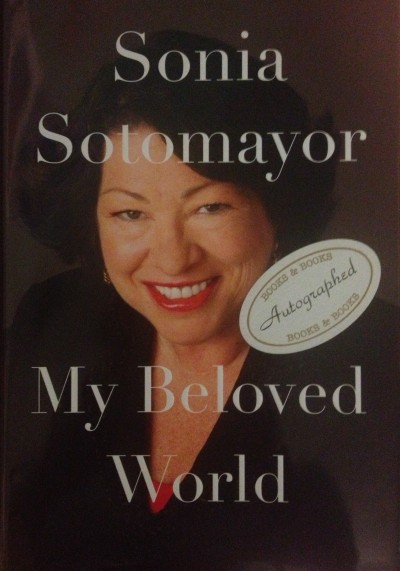Posted Feb. 26, 2013
By STEPHANIE PARRA
“My Beloved World”
By Sonia Sotomayor
A U.S. Supreme Court justice presently sitting on the bench, employed by the American people, rarely steps out of his or her chambers and confides in society – but Sonia Sotomayor certainly did so with the release of her non-fiction book, “My Beloved World.”
 Sotomayor sprinkles her text with memorable anecdotes documenting most of the experiences that shaped her to be the person she is within the black robe. She explains that she has written the work in order to remind herself of her roots and origins. Yet, within her piece, she documents experiences that an average Hispanic young woman may find not extraordinary, but somewhat mundane.
Sotomayor sprinkles her text with memorable anecdotes documenting most of the experiences that shaped her to be the person she is within the black robe. She explains that she has written the work in order to remind herself of her roots and origins. Yet, within her piece, she documents experiences that an average Hispanic young woman may find not extraordinary, but somewhat mundane.
Sotomayor takes for granted the 16.7 percent of Hispanic readers within the United States she writes for, and makes her “difficult quest” seem exclusive to herself. Her journey as a Hispanic woman crusading the educational and later corporate ladder through the 1960s, ‘70s and ‘80s is inspiring and admirable, but not singular. Her story is moving, but not as exclusive as she paints it.
As a seven-year-old, Sotomayor’s doctors discover she developed Type 1 diabetes. She documents her struggles in almost a self-deprecating way, and explains how she learned to give herself insulin shots each morning. Though medical advances for diabetics at the time were nonexistent, she explains how she received the best care the Bronx, her hometown, could offer.
As the daughter of a nurse who valued education above all else, and of a mediocre, alcoholic father who worked at a factory, Sotomayor describes the commotion and chaos that surrounds her home until the age of nine, when her father dies of alcoholism.
Dubbed by some as the “Oprah” of the Supreme Court bench because of her ability to emotionally connect to the public, she vividly portrays to her readers some of her most memorable moments as a child. She describes what it was like losing her closest childhood friend at a young age, when he moves to California. She describes the difficulties of growing up as the daughter of non-educated Hispanics in a time where Google was not there to answer questions no one else could answer for her.
She claims that when she reached high school, neither her English nor her Spanish were excellent. She explains that, in Spanish, she could not pronounce her own last name. Yet, she fails to blame her parents for her poor language skills, but rather unsatisfyingly implies it.
She explains her mission to find mentors with almost a sense of superiority, and not with the self-deprecation that may be observed in other portions of her text. Despite growing up in a home where Spanish was spoken, she explains her lack of fluency in Spanish grammar. And, though her mother exposed both her and her brother to “the best education around,” she claims her English suffered.
Still, she grew up with aunts and uncles who spoke English. At times, the “difficulties” she encountered with both the English and Spanish languages seem exaggerated, seeming especially so to a bilingual Hispanic woman reader.
Despite her “language barriers,” Sotomayor demonstrates how her education has grown since her childhood days. Holistically, the book’s diction remains exquisite – she demonstrates that she can write other pieces that do not deal with the law. Her descriptions of growing up as a child in the Bronx are vivid; the images she provides the readers with are relatable, humorous and exceptionally crafted. She uses words to provoke otherwise difficult feelings to stir within the reader, such as nostalgia, but she fails to transition properly between the anecdotes of her life.
Though each chapter represents a particular turning point in her life and the book is presented in chronological order, it is difficult to keep track of time when no such markers are present within the text.
Sotomayor’s personal, early life is unfolded in a series of anecdotes, where she provides readers with glimpses into her life. She does not include her personal views or opinions in her book, as she should not reveal to the public any glimpse into her judicial inclinations. She explains that her role models were television lawyers and judges. She watched “Perry Mason,” as a child, and explained that at nine years old she wanted to one day wear the black robes she saw on television. Though she makes it seem like unknowns have surrounded her entire life, she explains how she tried to emulate those around her in order to succeed. She met people who eventually became mentors, and asked questions whenever she felt necessary and proper.
Her quest to success is notable, but again, not exclusive. She is not the first Hispanic woman to succeed in the United States, and she fails to recognize that, which tends to make herself sound as though her quest and the difficulties she encounters belong only to her. She leaves the readers when she takes her first set of robes in 1992, almost 20 years ago. It is fitting that she leaves the readers there, as Supreme Court Justices should, by very definition, remain closed from the public opinion. And, while she explains with her text that she, too, is a human being, she does so tastefully by leaving the reader as soon as she puts on her first set of black robes.
Rating: 4/5 stars
Title: “My Beloved World”
Author: Sonia Sotomayor
Publisher: Knopf; first edition, Jan. 15, 2013
Language: English, non-fiction. Insert with relevant pictures located in the middle.
Length: 336 pages
List Price: Hardcover, $27.95
